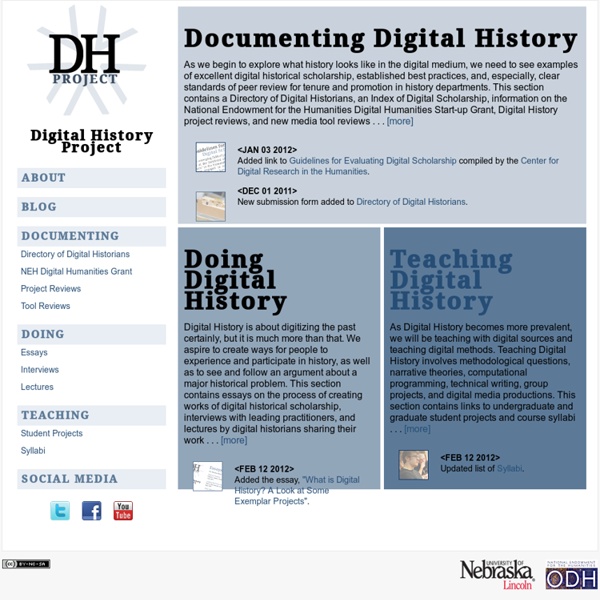



Digital History: A Guide to Gathering, Preserving, and Presenting the Past on the Web This book provides a plainspoken and thorough introduction to the web for historians—teachers and students, archivists and museum curators, professors as well as amateur enthusiasts—who wish to produce online historical work, or to build upon and improve the projects they have already started in this important new medium. It begins with an overview of the different genres of history websites, surveying a range of digital history work that has been created since the beginning of the web. The book then takes the reader step-by-step through planning a project, understanding the technologies involved and how to choose the appropriate ones, designing a site that is both easy-to-use and scholarly, digitizing materials in a way that makes them web-friendly while preserving their historical integrity, and how to reach and respond to an intended audience effectively. On this website, we present a free online version of the text. , Barnes and Noble, or U. of Penn. Press.
History of Oral History: Foundations and Methodology Digital Collections and Aggregations | DH Curation Libraries, museums, and archives have been producing digital collections for decades, providing scholars with broad access to countless special collections. Researchers engaged in digital scholarship have also created many digital collections tailored to the interests of their particular research communities. Both kinds of collections are curated, in that they have been carefully selected and assembled for a specific purpose or audience. In the networked information environment, curated collections will become increasingly important as organizational units for the scattered and diverse mass of available digital information and for providing coherent contexts for meaningful engagement with that information. Aggregations, or collections of collections, are essential backbone resources in the evolving e-research platform that also need to be curated if they are to truly support and enhance discovery and innovation across the disciplines.
3: Building Community » Tooling Up for Digital Humanities Perhaps the greatest development in developing online community is the emergence of Creative Commons in 2001. Creative Commons creates copyright licenses that are free and open to the public and which allow creators to share as much or as little of their work as they like. Rather than the traditional “all rights reserved” copyrights, Creative Commons allows creators to reserve some, all or none of the rights to any piece of work. With Creative Commons, scholars can post information online and put a Creative Commons license on it that allows it to be shared in ways the author sees fit. Creating an online presence is not only an important piece of self promotion, but also a critical part of being a connected and engaged scholar.
What is Knowledge Mobilization? — Institute for Knowledge Mobilization Note: This page is a reprint of an original resource created by KMbW on a previous web platform. This version includes and updates the text and links. This version also includes the transcript of the video discussing “what is knowledge mobilization?”. Background: Knowledge Mobilization as a concept, was introduced in Canada in 2001-2002 by the Social Sciences and Humanities Research Council of Canada ( SSHRC ) under the leadership of Dr. The definition of mobilization was taken in large part, from the French conceptualization – mobilisation – making ready for service or action. It was determined at the time that the ability to use much of what was produced in the social sciences and humanities was hindered by the conceptual and physical inaccessibility of the “production” of this sector. KMbW’s Founding Perspective Never in human history have we hunted for so much data, information and knowledge. Production of Value Value is always created in exchange. Some core questions include:
Writing History in the Digital Age New University: Re-Claiming Higher Education for All The New University Cooperative consists of students, professors, academics and community members from around Canada. Incorporated in 2008 as a solidarity cooperative, we are committed to developing an institution for higher education that is grounded in sustainability, social justice, and that is accessible to all. Given the massive environmental and concomitant social crises that face humanity today, such as climate change and growing social inequality, we believe that we need an institution that fosters innovation and leadership to help bring about sustainable communities. Young people today are told they must seek some post-secondary education in order to be “successful”, however the costs of university has risen steadily, limiting accessibility. The New University Cooperative seeks to provide students with the space that is accessible to marginalized individuals, so that students can create and enact visionary ideas, and provide leadership towards a sustainable and just world.